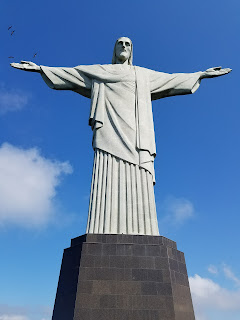April 29-Salvador:Market and Walking Tour

Today in Salvador they celebrated Saint Benedito Day and there was a precession of people from the Our Lady of Rosary of Black Men and Black Women Church throughout the square of Old Salvador. Salvador was the first capital of Brazil for 200 years. First place we stopped was the famous lighthouse. This was built in the 16th century and has a breathtaking view of Baía de Todos os Santos. Baía is Portuguese for bay. Next we stopped at the market. Connie explained to us that 10,000 people work at the market. Fruit, vegetables, pottery, and a lot of African candomblé items of all types are sold throughout the entire market. From here we headed to Old Salvador where we had a cooking demonstration on the native Salvador dish called Moqueca. This consists of dorade fish marinated with a garlic paste, cilantro, and lime juice. The other ingredients that the fish is cooked in are coconut milk, tomatoes, onions, garlic, and fresh c...





